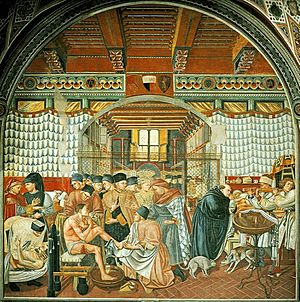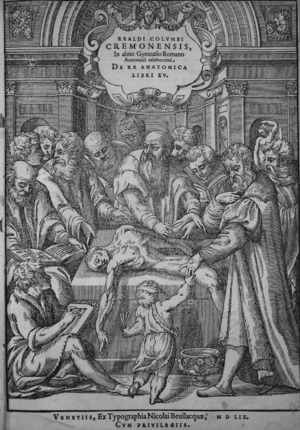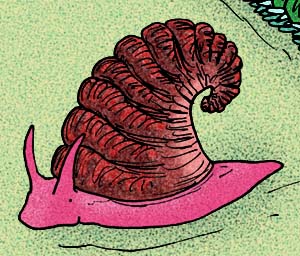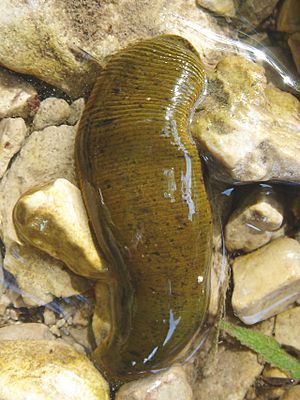Medical Renaissance facts for kids
The Medical Renaissance was a time of big changes in medicine in Europe, from about 1400 to 1700 AD. During this period, people became very interested again in the ideas of the ancient Greeks and Romans. The new discoveries made during the Medical Renaissance helped create the modern medicine we know today.
Doctors learned a lot by studying anatomy. This is the study of how the body is built, including bones, muscles, and organs. A famous doctor named Andreas Vesalius published a book in 1543 called De humani corporis fabrica. This book was important because it was the first time anyone published realistic diagrams of dissections. Dissections are when you carefully cut open a body to study its parts.
Later, in 1628, an English doctor named William Harvey made a huge discovery. He found out that your blood is pumped by your heart. He showed that blood travels all around your body in blood vessels and then comes back to the heart. This is called the circulatory system. These discoveries helped doctors start to understand basic facts about how the body works.
Old Beliefs About Sickness
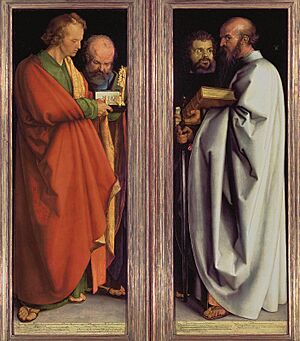
For a long time, doctors believed in a theory called the Four Humours. This idea came from the ancient Greeks and was popular until the 1800s. The theory said that your body had four main liquids, or humours: black bile, yellow bile, phlegm, and blood.
Doctors thought that if these humours were balanced, you were healthy. But if they were out of balance, you would get sick. To make you better, they tried to bring the humours back into balance. The Roman doctor Galen also supported this theory, adding his own ideas to it.
However, some doctors started to question this idea. Rhazes (who lived from 865 to 925 AD) was one of the first to say the Four Humours theory was wrong. He even wrote a book called Doubts about Galen. He did experiments that showed the body reacted to things in ways the humour theory couldn't explain.
Later, Avenzoar (1091–1161) did dissections and autopsies. He found out that the skin disease scabies was caused by a tiny parasite. Getting rid of the parasite cured the patient. This cure didn't involve balancing humours, which showed the old theory was wrong. Even later, Ibn al-Nafis (1213–1288) also disagreed with the humour theory after he discovered how blood flows through the lungs and heart.
Medicine or Myth?
Because doctors in the past had few ways to study the body, they didn't always know how to cure sickness. When a serious plague started, they couldn't do much to help patients, except maybe make them feel a little better.
One mistake they made was thinking that diseases were carried by "flying venom" or bad air. So, they would cover their mouths or burn good-smelling leaves. But they didn't wash their hands after touching sick people. This meant they often spread diseases without knowing it.
When William Harvey was working in 1618, only a few doctors were trying to figure out how the body really worked. Many people thought Harvey was a fake doctor when he said the blood was pumped by the heart. But slowly, people began to see that his discoveries were true.
In the 17th century, Anton van Leeuwenhoek and Robert Hooke made the light microscope. Using his microscope, Leeuwenhoek was the first person to see tiny living things, like bacteria, in 1676. He called them "animalcules." The name bacterium came much later, in 1838.
Some old cures were not only useless but also dangerous. For example, doctors often thought that if someone was sick, "bad blood" needed to be removed. To do this, they would put leeches on the patient. Leeches are animals that suck blood. When the leech was full, they would remove it. But taking blood from a sick person could make them very weak, and they could even die.
As science and medicine got better, doctors stopped using leeches. However, recently, doctors have found a new use for leeches. Sometimes, if a patient has a finger or hand reattached after an injury, blood can pool under the skin. Leeches can help by drinking this extra blood, which reduces pain and helps the reattachment heal.
Some old cures actually worked! For example, sometimes wounds that we would stitch today were held together using beetles with pincers. The edges of the wound would be pinched together by a big, angry beetle. Once the pincers were holding the wound firmly together, the beetle's head would be cut off. Spider webs were also used to help wounds clot, meaning the blood would come together and stop bleeding. Doctors today are still studying some of these old "cures" to see if they can help modern medicine.
Related pages
Images for kids
-
The front cover of De Humani Corporis Fabrica by Andreas Vesalius. It shows a public dissection being done by Vesalius himself.
-
This drawing by Leonardo da Vinci shows a foetus in the womb. He made many detailed drawings of human anatomy.


